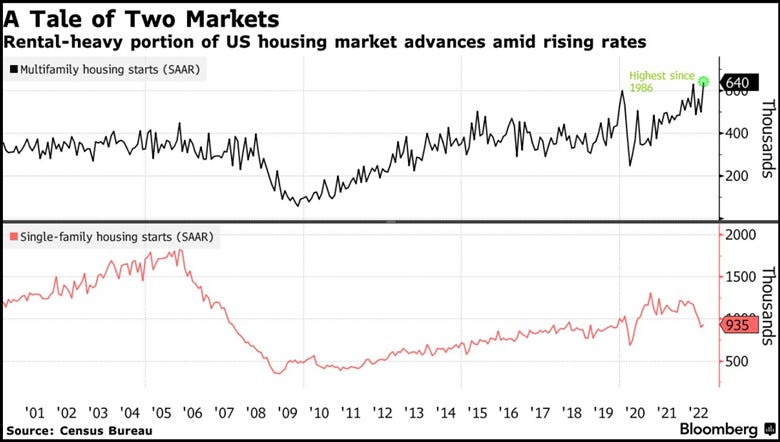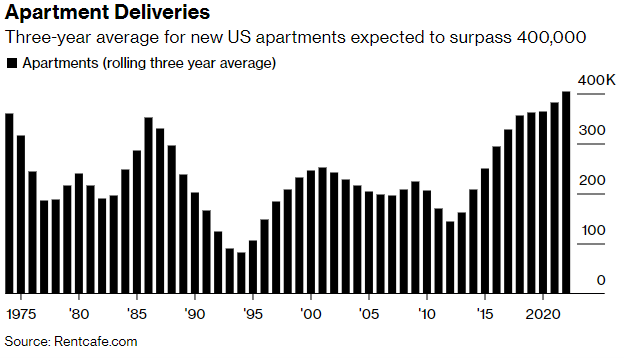Opinion: rent growth in NYC will continue
Retelling of of why rents flew up in the last 2 years and evidence to support why they will they decline nationally, but not so in NY (even if nominally so in next 6 months)
Things we know are happening:
Investors are swooping in to buy SFRs in bulk at wholesale discounts due to waning demand.
Interest rates on residential and commercial mortgages are approaching 7%, with 30 year fixed mortgages hitting 6.7% for home mortgages last week.
Remote work is responsible for much of the housing price increases.
There are more people living in Manhattan today than there were pre-pandemic.
This leads me to ask…
Will rents keep rising in the U.S?
It depends. The way the data is dissected, and which geographies are observed will lead to varying results. Consensus is hard to find even amongst apartment rental marketplaces. Across websites like Zillow, Realtor.com, Apartment List, and Zumper, the results are varied. Are rents declining in absolute terms, or just seeing declining rates of growth? Move one county over and that answer will be reversed. You get the idea.
What IS clear is that there will no longer be the kind of explosive growth that renters witnessed in the last 12-18 months after covid fears abated. In most markets, apartments are renting nearly 15-20% higher than last year this time. When you get into the weeds, the month-over-month rent growth numbers are much lower than what they were last year. Some markets are even seeing August rents decline slightly from their July 2022 highs.
Thinking through the last few years helps us understand this intuitively as well. During Covid there was a surge in relocations. The first relocation happened when young people, unemployed, and low-income populations moved back in with family. The second relocation was somewhere around vaccination time when people across the world breathed a sigh of relief and decided that 3 months of confinement with their families was enough to last a lifetime. The mass exodus from metro hubs was replaced with a mass return. The sudden vacancies in Manhattan circa April 2020 gave way to a sharp rebound in occupancy rates for apartment buildings. People returned to NYC and other cities and worked remotely from their apartments. Except now they needed private office space and maybe a place for their pelotons (R.I.P). Many 20-something year olds left behind their roommates. Demand surged and rents were still weakened from Covid-induced vacancies. Renters had Whole Foods quality options at Trader Joe’s prices. Word got out and more and more young folks took advantage of these covid deals – including, we can imagine, some price-sensitive shoppers who wouldn’t have moved to big metro hubs were they not so discounted. A large supply of apartments met a growing demand.
In 2021, inflation was well under way and multifamily housing providers struggled to maintain their prior year operating margins. Owner operating expenses increased significantly alongside inflation. Without intervention from government, and with some tenants perhaps not paying rent, the only way forward was to raise rents. Big rent pops made headlines, but the surge in building operating expenses remained a much quieter, driving force behind rent hikes. According to some owners like Nitya Capital’s Swapnil Agarwal, who manages ~20,000 units, “net operating margins [for multifamily owners] have… gone down.”
But the narrative has started to shift, and the market is signaling that peak rent has already happened. New construction starts are at their highest levels since 1986 and sit 70% higher than they did as recently as 2019. Approximately 640,000 new units began construction this year. This coincides with interest rates growing to their highest levels since 2006. The demand for housing is strong enough that developers are undeterred by rising costs of capital.
Note: Multifamily construction starts are at their highest since 1986 and are picking up the slack in the residential home market. Source: Bloomberg.
On top of the construction starts, apartments delivered to the market are also hitting their peaks. According to data from Rent Café, apartment deliveries will increase to their highest annual level in 50 years. Combined apartment construction in the top 5 markets for apartment deliveries (NYC, Miami, Austin, Seattle, and Phoenix) will reach approximately 100,000 new units, compared to only 67,000 in 2018. The air is starting to change.
Note: New apartment deliveries are at their highest in the United States since 1972.
On the other hand, according to economist Paul Krugman, markets like New York and California that are more regulated than other states will bear out different trend lines. The answer to rising rents is to build more units. But in states like NY and CA, a nuanced regulatory environment limits the supply of new apartments. This means rent growth should be expected to decline more gradually in NY and CA than in other regions. In other words, if this view is endorsed, rent growth will persist at higher levels and for longer than most anywhere else in the United States. The data on NYC multifamily development implies a much slower pace of construction than elsewhere. On average, from 2010-2020, Manhattan built only 30 units a year per 1,000 residents. This implies a population growth rate of 3%. But NYC saw population growth of 7.7% during that time (and employment growth of 22%). Los Angeles only saw a modest 2.8% population increase from 2010-2019. That’s 2.75x less the population growth in NYC. But Los Angeles still had more building permits distributed than NYC.
Note: Relative to population growth, New York has severely lagged in its housing starts and permits. Source: Citizen’s Budget Commission.
The below chart also summarizes the story well – NYC’s housing stock just hasn’t kept up with its population and job growth.
This chart is WHY Manhattan median rents hit $4,050 this summer!
Job & housing growth in NYC (1980-2018)
Nationally, if construction trends continue, there ought to be a natural cooling effect on the rental market, whereby increasing supply of apartments provides more options for tenants and leads to lower rents. In NYC the story is a bit more muddied. If trends continue, rent growth will continue, albeit at a slower pace.
To stay connected to my opinions and analyses, follow my newsletter here.
Sources: Citizen’s Budget Commission, Bloomberg, NY Times, WSJ, FRED Economic Data






